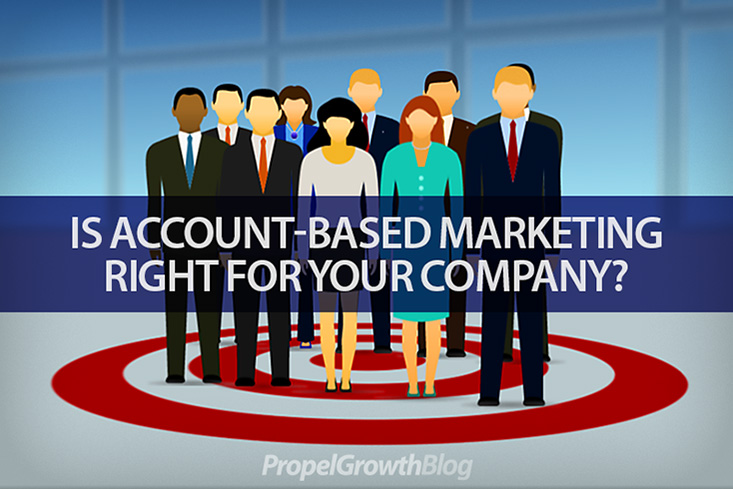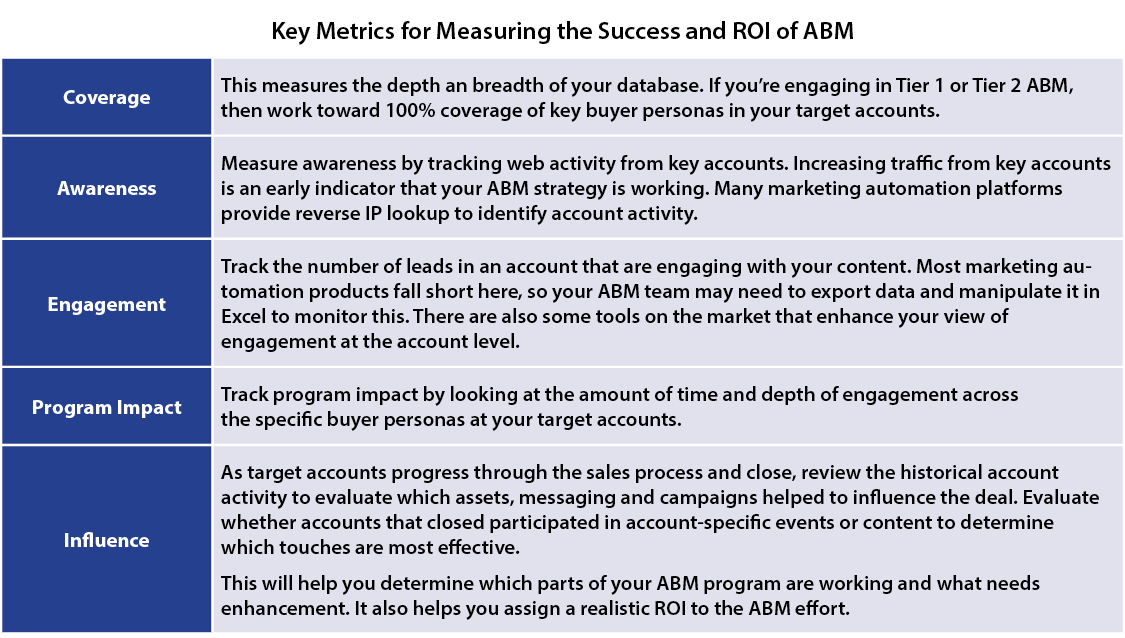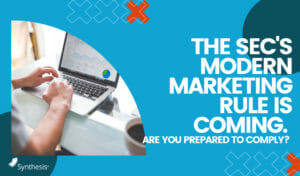Is Account Based Marketing Right for Your Company?

You probably see the term “account-based marketing” (ABM) pretty frequently of late. The hype has grown over the past 12 months, with hundreds of articles, blogs, webinars, podcasts, videos and events devoted to the topic. At least a few dozen new vendors have sprung up with solutions focused on ABM, adding to the noise.
Even with all that noise, most organizations are unclear about whether and how to implement these strategies. So this post will give you a high-level sense of what ABM is all about, give you concrete criteria on whether you should consider it for your organization, help you decide what type of ABM would be appropriate, and give you a couple of practical steps to get started.
This post originally appeared on the Propel Growth blog.
What is Account-Based Marketing?
Account-based marketing is a way for marketing to support a target or key account selling strategy. If you target specific, highly defined niches or key enterprise accounts, then ABM combined with a target account sales strategy can make your efforts far more effective. An Alterra study found that 84% of marketers who are using ABM say it is dramatically increasing the effectiveness and ROI of their marketing.
ABM Increases Sales and Marketing Alignment
If done correctly, account-based marketing methodologies will tightly align marketing and sales, as they agree to target very specific accounts, do deeper research into the needs at those accounts, and create content to support the full sales cycle for those accounts. The joint effort helps Sales get in the door with the right people, nurtures everyone in the buying committee, and overcomes objections that the salesperson doesn’t always hear. A SiriusDecisions study found that B2B organizations with tightly aligned marketing and sales achieved 24% faster revenue growth and 27% faster profit growth over a three-year period. Here’s a Forbes article about the study.
ABM Develops Deeper Subject Matter Expertise
B2B executives have zero patience for old-school salespeople who rely on glad-handing, manipulation high-pressure techniques to close deals. In fact, many buying committees will eliminate a vendor from consideration based on a negative sales experience. Customers want and need subject matter experts who can help them make well-informed decisions. This demands that salespeople take a consultative approach.
A well-executed ABM strategy is based on deep research into the specific accounts to find out what problems the accounts are facing and developing messaging that is truly meaningful to that prospective client. When Sales and Marketing work together to research accounts and develop an account strategy, they develop valuable insights that they can leverage to become trusted advisors within target accounts. The process also forces the team to be more selective about which accounts to cultivate, leading to a better fit for both the customer and vendor.
Three Tiers of Account-Based Marketing
You can break ABM into 3 tiers going from the most targeted to the least. In the next section, you’ll find a decision tree that helps determine if ABM is right for your firm.

Tier 1 is the classic approach to account-based marketing. Think of Tier 1 as “marketing-enabled strategic selling.”
Tier 1
A dedicated marketing resource is paired with an account team to go after very specific named accounts. The marketer should be closely aligned with Sales, helping with the account research and also leveraging what Sales is learning in the field. By collaborating, the marketer can help identify, create, and/or re-purpose content that is specifically relevant to the target accounts and highly personalized for a specific account’s situation and business needs. If the target accounts are in the same industry, then the content becomes more re-usable. You’re essentially marketing to an audience of one company – creating very personalized content and distribution strategies to target specific people.
For Tier 1, a marketer can generally handle only 3-5 accounts effectively, and it’s best if those accounts have similar needs and are in similar (or the same) industries.
Tier 2
Tier 2 is similar to Tier 1 in approach, but because you’re targeting more accounts, you can’t be as specific with the personalization. I call this tier “ABM-lite.” Tier 2 works best if all the target accounts have a lot in common (e.g., same industry, same type of company, similar size, similar business needs, similar regulatory environment). In Tier 2, it’s important to plan your research carefully, ensuring that it covers a cross-section of the target accounts. Otherwise, your insights could be so narrow that they’re not applicable to the whole group or so broad that they don’t bring enough value to the audience.
For Tier 2, a marketer can generally handle a group of 10-20 accounts that are highly similar.
Tier 3
Tier 3 targets more broadly and is essentially a niche strategy. Frankly, at this level, I don’t see much difference between ABM and well-researched, persona-based marketing.
In this case, you’re targeting specific accounts, but the list is so large that you can’t personalize content for every prospective account without using technology. There are dozens of marketing technology vendors focused on supporting an account-based strategy. Tier 3 is where most of them focus. Here’s a helpful list.
Should We Adopt Account-Based Marketing?
Your decision on whether to adopt ABM should be based on the size accounts you’re pursuing. Below is a decision tree to help you decide.

If your company sells a product to the mass market that appeals across many verticals, and if your typical lifetime client value is less than $100,000, then account-based marketing is not a good fit for your firm. It will cost too much and is not a good use of your marketing budget. Focus on persona-based marketing instead.
How to Get Started with ABM
If you’re convinced that ABM might be right for you, then the first step is to figure out which accounts to target.
Account selection is critical to the success of this type of program. Don’t allow the team to be subjective on this decision. Focus on demographic information about the accounts that validate the value, but also look into the specific business situation of the accounts to ensure that they represent a valid target.
Next, identify the specific people to target. Start with a list of the names you already have in your database for the target accounts and identify gaps. Then, do what’s necessary to fill those gaps and get the names, emails and phone numbers for the missing people. There are many vendors that can help with list enrichment and hunting down the relevant roles. You probably won’t get all your needed contacts from a single source. So be creative, investigate options, and experiment.
Once you have the names, sales and marketing should engage in both outbound and inbound programs to attract the attention of the target personas.
Develop account and persona-specific offers and campaigns to attract the attention of your target accounts. In addition, create offers that can help get a first meeting for your sales team. For example, you could create an assessment tool for Sales that allows them to analyze an aspect of the customer’s business. Then Sales conducts the assessment during a 1-hour meeting with the client. For example, you might offer to assess current costs for a specific business function and give them a report that compares their costs to industry standards.
Set Reasonable Expectations for Metrics
Most marketers are used to pumping out volumes of new leads, most of which never convert into sales opportunities. But with ABM, your focus should be on quality, not quantity; and on influence, not net new leads.
As David Olgilvy said, “Don’t count the people you reach; reach the people who count.”
Your focus in ABM should be on three key metrics:

If you’d like to discuss whether ABM is right for your firm, shoot me an email [email protected].
For all of the insights and takeaways from our Annual Marketing Roundtable Event, download your copy of the 2017 Roundtable Report
Here are some related resources that might interest you:







 Compare the Top 3 Finserv Content Automation Vendors [White paper]
Compare the Top 3 Finserv Content Automation Vendors [White paper] Create Pitchbooks the Drive Sales [White paper]
Create Pitchbooks the Drive Sales [White paper] Build vs. Buy: Should Your Financial Services Firm Outsource or Insource Marketing Technology? [White paper]
Build vs. Buy: Should Your Financial Services Firm Outsource or Insource Marketing Technology? [White paper]  10 Tips for Rebranding your Fund Marketing Documents [White paper]
10 Tips for Rebranding your Fund Marketing Documents [White paper]




